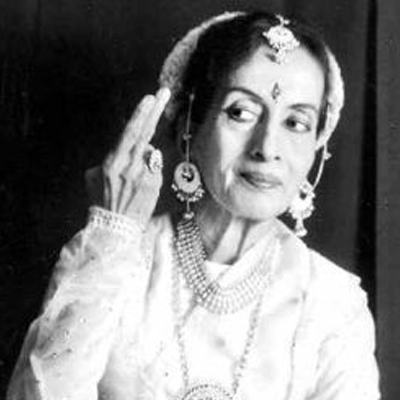
Born in Mumbai on December 5, 1932 to Vatsala Joshi, Damayanti was "adopted" by the well known scientist of the times, Col. Sahib Singh Sokhey and his famous dancer-wife Madame Menaka as their own.
Menaka had lost her daughter earlier and thus took to Damayanthi as her own. A rather weak child physically, Daman got attracted to the sounds of ghungroos emanating from Madame Menaka's classroom where Pandit Sitaram Prasad of the Lucknow gharana taught.
He was a direct disciple of Bindadin and taught many girls in the neighbourhood. Kathak then was very popular in Bombay. When Damayanti was six, Madame Menaka included her in her twoyear tour of Europe, beginning with Switzerland. It was Daman's first exposure to snow and ice. The group of thirteen members was like one big family. Madame Menaka won three prizes for India but in Germany war clouds loomed large and soon the troupe returned home, only to prepare for a tour of the U.S.,sponsored by Menaka's impresario, Ernest Cross of Amsterdam. Back in Bombay, they were preparing for the tour when one day Lachchu Maharaj walked in to meet his cousin, Ram Narain Misra, principal dancer in Madame Menaka's group.
Upon seeing such a great teacher, Madame Menaka engaged him to help create a new ballet for the U.S. tour. Menaka had an influential circle of friends and admirers among which were knowledgeable advisers like Kanhayalal Vakil, the critic and lawyer; Karl Khandwala for costumes and decor; Moloyshree De (of Santiniketan) for music and Dr. V. Raghavan of Madras for literary inputs. However, the American tour fizzled out due to the War and some artists who had joined, left too. Madame Menaka started her first institution in Khandala but the distance proved cumbersome, so she moved it back to Bombay. Madame Menaka suffered from a kidney ailment and desired that young Damayanti take the responsibility of conducting classes but Damayanti's mother stepped in and requested Madame Menaka to groom Daman for a career in dance as a soloist and not burden the child with the responsibility of classes. Thus began Daman's serious training in Kathak under Lachchu Maharaj. He had trained several leading aspirants of Kathak, especially girls attracted to the film world of Bombay like Meena Kumari and later Kumudini Lakhia nee Jayakar.When the guru saw the single-mindedness of Daman, he commented to Menaka: "You have made the right choice, this girl will be a star of Kathak."
People who saw her dance progress well, became jealous and asked the guru why he was training a Maharashtrian but he retorted that he was grooming a dancer, not a Marathi. At the Meerut Music Conference (a bit like the sabha season of Chennai, these music conferences in north India were big events where music was the main draw and occasionally dancers of repute were invited too).
Forever keen to learn, Damayanti applied to learn under Shambhu Maharaj when he interned in Delhi, brought by Nirmala Joshi to teach at the Bharatiya Kala Kendra. She was refused admission as she was over-qualified and already established and popular. Many years later, Damayanti returned to this committee as member! Damayanti's Kathak is best remembered for its slow, languorous, solid and deep delivery. There was no need to impress, to shout, to suffer cheap mannerisms. She did slow and meaningful thumri-s and in her footwork lay the firm foundation of tayyari and taal. She was the queen of rhythm and bhava. Damayanti danced in a saree and moved minimally because her dance was grounded. She felt there was no need to impress like a ten-year old child.
She was conferred the Sangeeth Natak Academy award in 1968 and Padma shri in 1970.Her passing in 2004 after a stroke was mourned deeply.


